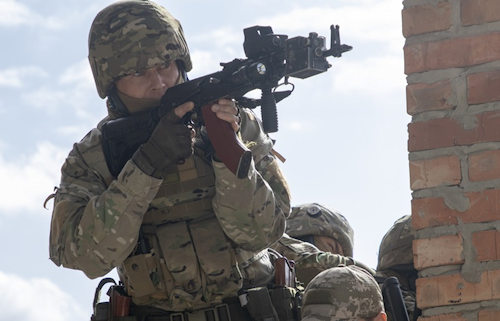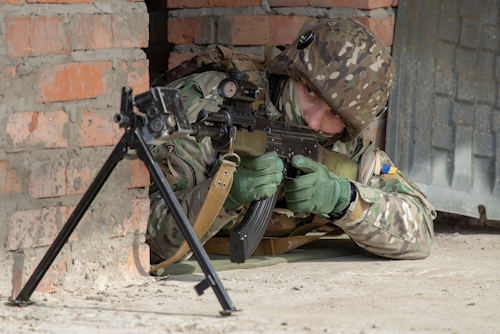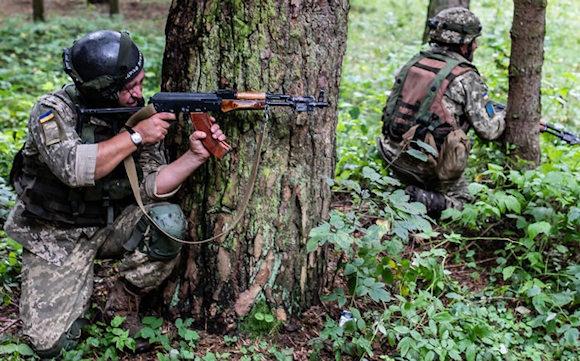We have thus finished the examination of the complex of forces that make up the Armed Forces of Ukraine. Alongside them, however, Ukraine has other military, paramilitary or "militarizable" forces which, in the event of total war, could contribute to the defense of the country's territory to varying degrees. One of these is the aforementioned State Emergency Service, but in addition to it there are also the Border Guard (which controls, as a sub-group the Coast Guard), the National Guard (heir to the troops of the Soviet Interior Army memory), the various paramilitary forces that report to the Security Service of Ukraine (SBU, heir to the local KGB), the National Police of Ukraine (reformed on the ashes of the Militsiya inherited from the USSR) and the famous Territorial Defense Forces born in the wake of Euromaidan, the Russian annexation of Crimea and the outbreak of the Donbass War to mobilize volunteers and thus support the conscripts of the Armed Forces, who had initially proved poorly suited to fight a war prolonged.
The (theoretical) mobilization capacities of all these entities are as follows:
- Armed Forces: 250.000 soldiers plus 900.000 reservists;
- National Guard: 50.000 men;
- Border Guard: 50.000 men;
- State Emergency Service: 60.000 men;
 - Paramilitary forces of the Security Service of Ukraine, SBU: 30.000 men;
- Paramilitary forces of the Security Service of Ukraine, SBU: 30.000 men;
- National Police: 130.000 policemen;
- Territorial Defense Forces: 10.000 men on active duty plus 130.000 volunteers.
This gives the military forces of Ukraine a theoretical total of 1.610.000 men who can be mobilized in "reasonably short" times (the conditional in this case is a must). It is obvious that such a number of possible fighters would lead at first glance to very carefully evaluate the possibility of an invasion, no matter if it is on a small or large scale, but this reasoning, albeit linear, clashes with the fact that, as they show the example of France in 1940 or Iraq at the time of the Gulf War, the numbers on paper and the "wealth of war material available" do not always automatically guarantee victory in wars and, as we have seen, it did not to desist Russia from attacking.
Precisely the French Campaign and the Gulf War offer us some interesting lessons that could be useful in anticipating the outcome of the current conflict between Ukraine and Russia (plus its allies).
In 1940 the French Armed Forces, considered at that time the most powerful in the world and second in size, after the Soviet ones, were crushed by Hitler's Wehrmacht in 46 days of war, and in 1991 the Iraqi Armed Forces, then the fourth in the world in size, very rich in armaments equipment (some of which of the most modern standards!) and strong in an enviable combat experience gained during the 8-year war fought against Iran (the longest conventional war of the twentieth century !) were completely overwhelmed and disrupted by the forces of the American-led International Coalition after 42 days of bitter fighting (the so-called "1.000 Hour Air War" followed by the "100 Hour Earth War") despite predictions on paper at the beginning of conflict were anything but unfavorable to Iraq.
 Reading the numbers provided in this series of analyzes, Ukraine theoretically has a large number of men at its disposal, but are they adequately equipped? Are they equipped with the command and control tools and tactical-strategic plans such as to be able to organize an effective resistance? Has the Ukrainian state prepared the delegated organizations to carry on a guerrilla war protracted over the years in case its conventional forces are defeated and its territory occupied?
Reading the numbers provided in this series of analyzes, Ukraine theoretically has a large number of men at its disposal, but are they adequately equipped? Are they equipped with the command and control tools and tactical-strategic plans such as to be able to organize an effective resistance? Has the Ukrainian state prepared the delegated organizations to carry on a guerrilla war protracted over the years in case its conventional forces are defeated and its territory occupied?
In fact, we have partially answered these questions in the text of the analysis "Swarm of Fire”Which I warmly invite you to re-read. In the case of an all-out war in which Ukraine is confronted fully with the strength of Russia and the separatists of Donbass (and now perhaps also of Belarus and Transnistria) as we are seeing today, I would like to venture the prediction that there is no possibility for the Ukrainians to win the contest on a conventional level.
As already mentioned above, a large part of the Ukrainian arsenals have been in storage for a long time and need a complete overhaul before being operational again; what the Ukrainian state has failed to do in 8 years, no longer be done in a matter of days, let alone under bombs!
As for the operational means, most of them are not up to date and cannot compete on a technical level with the Russian ones.
Last but not least, despite 8 years of experience in Donbass (which in any case are in no way comparable to the Iran-Iraq War!) The Armed Forces and other military structures of Ukraine have neither the training nor the operational experience such to be able to compete with Russia on equal terms.

The progress of military operations in the Donbass, from 2014 until today, is enough to understand that the entire military instrument available to Kiev has been reformed with the aim of facing a "sub-conventional" military campaign against non-state actors but not a full-scale confrontation against an opponent of equal or greater size, as was the case, for example, for the Polish Armed Forces. This is a very important point because in the military field everything is calibrated on the basis of the operational scenarios and the enemies that the military instrument of a given country “imagines it will have to face in the future”.
The operational posture, organization, training and equipment of the Ukrainian Armed Forces all point to the conclusion that Ukraine is neither ready nor able to fight a protracted full-scale war against Russia and its allies.
Even before "coming to blows", Russia already had absolute dominance over Ukraine in the space field and was in a position of substantial advantage in those of cyberspace and intelligence, despite Ukraine's attempts to bridge the gap in recent years.
Following the scenarios already outlined on "Operation Swarm of Fire" we can hypothesize that in the next 4 days of total conventional warfare, the Russians would concentrate on hitting the Navy, the Coast Guard, the Border Guard, the Air Forces as well as the units assigned to the anti-aircraft defense in order to gain complete freedom of maneuver on the sea, in the sky and around the country.
At the same time, the Russian Air Forces will repeatedly and relentlessly hit the command and control centers and the logistic lines in order to paralyze the Ukrainians' reaction capabilities. Those who believe that the Russian Air Forces are unable to carry out a sustained campaign of this type as described now and in the "Fire Swarm" analysis, do so only for "axiom" and "religious conviction" since, after the conventional part of the Wars in Chechnya and the Russo-Georgian conflict of 2008, the V-VS demonstrated on the occasion of its involvement in the Syrian conflict that it had completely reformed itself and that it had treasured the lessons learned from past conflicts. Furthermore, Moscow's planes are now equipped with precision weapons in much greater numbers than in previous years and are supported in bombing and troop support operations by electronic warfare (EW) systems against which Ukraine (and also a good number of Western militaries) are not equipped to respond equally and against.

Once these results are achieved, the methodical destruction of Ukraine's Ground Forces and other military organizations would only be a matter of time. In a context of conventional warfare, the most useful arsenals for Ukrainians in order to prolong resistance against the enemy are those made up of mines, backed anti-aircraft missiles and counter-tank missiles that would guarantee Ukrainian infantry to increase the losses among the infantry, enemy tanks, helicopters and planes operating at low altitudes, but even in the most benevolent scenario possible the final result of such war is not in question: Ukraine will surely be defeated.
The only two unknowns in this case are the duration of this war (11, 40, 100 days?) And whether the Ukrainian state presented itself in an orderly manner to the final surrender (like France in 1940) or whether under the pressure of war events collapsed completely (like Italy after 8 September) throwing the country and the civilian population into complete anarchy making the task of "rebuilding Ukraine from the ground up" much more difficult for the Russians and their allies.
And here we come to the final question which constitutes the real unknown of our narrative: can a guerrilla war really develop in a Ukraine under Russian occupation?
The answer is: yes, but how effective would it be and would the Russians be able to defeat it? Those who bet all their cards on this scenario do so with essentially 3 elements in mind:
- first: the large amount of weapons present in Ukraine which would feed a guerrilla;
- second: data released by the "Kiev International Institute of Sociology" according to which 33,3% of Ukrainians say they are ready to participate in the armed struggle against Moscow;
- third: the precedent of Afghanistan.
 With regard to the first point, it is true that according to estimates published by NATO, at the beginning of the hostilities there were two and a half million tons of conventional ammunition and over seven million pistols, rifles, mortars and machine guns, all "toys" that would be very convenient for a guerrilla movement, but these "arsenals" were kept in about 180 bases of the Ukrainian Armed Forces well known by intelligence agencies around the world and in fact, as can be seen from the videos that are starting to flood the Internet, they were from immediately bombarded by Moscow's aviation, ballistic and cruise missiles so it is very difficult to say how much of the Ukrainian arsenals was saved from the first destructive wave.
With regard to the first point, it is true that according to estimates published by NATO, at the beginning of the hostilities there were two and a half million tons of conventional ammunition and over seven million pistols, rifles, mortars and machine guns, all "toys" that would be very convenient for a guerrilla movement, but these "arsenals" were kept in about 180 bases of the Ukrainian Armed Forces well known by intelligence agencies around the world and in fact, as can be seen from the videos that are starting to flood the Internet, they were from immediately bombarded by Moscow's aviation, ballistic and cruise missiles so it is very difficult to say how much of the Ukrainian arsenals was saved from the first destructive wave.
The second point, on the other hand, is of a virtual rather than substantial nature. Despite popular beliefs, a guerrilla war is not improvised and indeed it needs a level of organization that can dwarf conventional armies. It is no coincidence that, during the Second World War and throughout the Cold War and the post-Cold War period, the countries that saw the most effective guerilla wars were precisely those in which, on the eve of the conflict, they were already present political parties, ethno-tribal factions or other centers of power of a subversive nature that had created organizational structures ready for struggle. It is not at all clear whether such structures exist in Ukraine today.
Certainly, the Ukrainian Armed Forces have not prepared any specially delegated force to unleash a guerrilla war in case of occupation of the country. Some political parties of the Ukrainian far right such as "Svoboda" and "Pravyi Sektor" with a strong presence of their militants in some of the battalions of the Territorial Defense Forces could theoretically fill this power vacuum, but what are their real chances of "breaking through ”In the“ battle for the hearts and minds ”of the majority of the Ukrainian population? Difficult to be able to quantify it precisely.
Lastly; the case of Afghanistan. It is simply inapplicable in Ukraine. The differences at all levels between the situation in Afghanistan and the Soviet Union in 1979 and Ukraine and Russia in 2022 are such that it is simply impossible to make a comparison.
Finally, we recall that, in the period between 1944 and 1956, the territory of Ukraine, especially the western one, was actually the scene of one of the most ferocious guerrillas (in this case anti-Soviet) in contemporary history and at a certain point up to 200.000 partisans were engaged in subversive actions against power and its authority but, despite everything, Moscow managed to prevail.
 In light of all this, we are left with the opening question of the present analysis that haunts the sleeps of the Kiev elite in this fundamental historical moment: resistance or yield?
In light of all this, we are left with the opening question of the present analysis that haunts the sleeps of the Kiev elite in this fundamental historical moment: resistance or yield?
After the latest geopolitical and diplomatic developments, with Putin's recognition of the independence of the breakaway republics of Donetsk and Lugansk and with the large-scale invasion of Ukraine, it seems that this choice is heading decisively towards resistance because, at present, surrendering without a fight would be tantamount for Ukrainian leaders to accepting a political price that is simply unbearable and, as the saying goes: "In war you can only die once, but in the ring of politics and diplomacy, an enemy can kill you countless times!".
It remains to be verified whether, as stated in the incipit of the analysis, the current Ukrainian political leadership is actually up to the task entrusted to it by history in this very delicate moment experienced by that tormented and divided land.
Ukraine to the test of fire: resistance or surrender? (first part)
Ukraine to the test of fire: resistance or surrender? (second part)
Photo: Army National Guard / US Army / US Air Force












